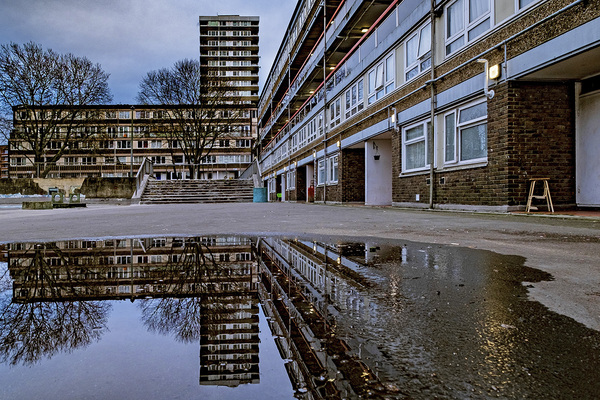Latest housing research: Right to Buy needs to be reformed
Richard Hyde, chair of the Thinkhouse Editorial Panel, discusses recent research into preserving new council homes
While fewer reports than normal were published in the past month, maybe because of the election, Reforming the Right to Buy by the New Economics Foundation (NEF) would have caught my eye at any time.
It is a concise, focused and hard-hitting analysis of the options available to policymakers seeking to reform the Right to Buy, and the importance of doing so. It recommends a package of powers that would help to increase social housing assets and advance the devolution agenda while allowing Right to Buy to continue to operate in areas in which social rent does not need to be prioritised.
As the practical and psychological impacts of Right to Buy on levels of council housebuilding in England are explained, and recent experiences of reform in Scotland and Wales are described, readers are left in no doubt that we cannot resolve the housing crisis without reforming the policy.
Since its introduction in 1980, Right to Buy has had a transformative impact. More than two million homes have been sold to around 4.5 million sitting tenants, allowing them to own their homes and access wealth which they had hitherto been denied. For actual and aspiring beneficiaries, Right to Buy offers a clear path to gaining financial security for them and their children, with greater control over their future as a result.
However, at the heart of our housing crisis lies a clear tension between the policy’s enduring appeal and its role in reducing the number of homes for social rent. Right to Buy has come at the cost of reducing one of the UK’s greatest national assets: its social housing stock.
The financial strings attached to Right to Buy have prevented councils from replacing sold homes. The policy has also triggered a loss of local authority confidence to build new homes. Partly because of the impact of Right to Buy, councils went from being in the vanguard of developing new homes in the decades immediately after World War II, to being bit-part players thereafter.
Moreover, the NEF found that 41% of former Right to Buy homes (820,000) have found their way into the private rental sector (PRS). As a result, they replaced secure tenure and affordable rent with insecure tenure and unaffordable rent, driving rising housing need and higher housing benefit costs for taxpayers.
Devolving Right to Buy to councils would place more decision-making powers and accountability in the hands of local politicians. At the heart of the report lies a suite of devolved powers, which would grant local authorities alternatives to the current system if circumstances demanded it. It outlines a menu of options for local powers, including suspension, ending the Right to Buy for newly built or acquired homes, preventing homes from moving into the PRS, and amending discounts and qualifying periods.
A council with high rates of homelessness and demand for social housing could encourage (or even guarantee) retention of the ownership of their homes, and one that wanted to curtail the growth of the PRS could take a firmer approach to prevent the private letting of sold homes. Councils with low demand for social rent homes but high demand for low-cost homeownership could adopt fewer (or none) of these measures.
Right to Buy has had a lasting impact on local authorities’ confidence and willingness to build new homes. Why would councils go to the trouble and expense of building new homes only to be forced to sell them at a sizeable discount, and to thereafter forego the rental income? Analysts have described the continuation of Right to Buy as the main disincentive to councils reopening their Housing Revenue Accounts. Ending the policy for newly built social homes could resolve this.
“Right to Buy has come at the cost of reducing one of the UK’s greatest national assets: its social housing stock”
Treasury rules around receipts should be recalibrated significantly to enable councils to better replace sold stock. Since 2012-13, the number of Right to Buy sales has outstripped replacement homes, with one built for every 2.6 sold. A proportion of the receipt from each sale has to be returned to the Treasury.
The report proposes that this should be abolished, and permission given for the retained receipts to be combined with other sources of funding to enhance councils’ ability to build replacement social homes. The cap on the proportion of replacement social homes that can be delivered by acquisition should be lifted and councils should be able to transfer receipts to ALMOs and local authority housing companies.
Finally, alongside other social landlords and community-led housing groups, councils should be given pre-emptive first-buyer rights permanently, rather than within 10 years of Right to Buy being exercised. Homes previously sold under Right to Buy are advantageous for councils to buy, given they are often already situated in council-owned blocks or on council land. This reduces the likelihood of complex freehold/leasehold arrangements with third parties and delivers economies of scale to reduce management costs.
In summary, in 37 pages of well-argued analysis, this report provides context and policy ideas for the new government and local councils to address the shortage of social housing, while at the same time retaining the national Right to Buy framework that creates opportunities for tenants to own their own home.
Richard Hyde, chair, Thinkhouse Editorial Panel
Sign up for our Council Focus newsletter
Already have an account? Click here to manage your newsletters














